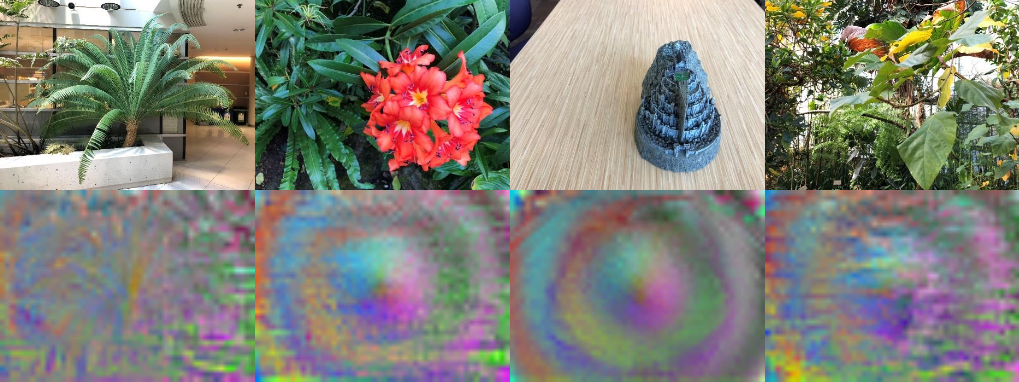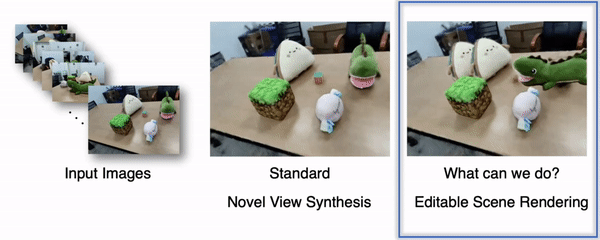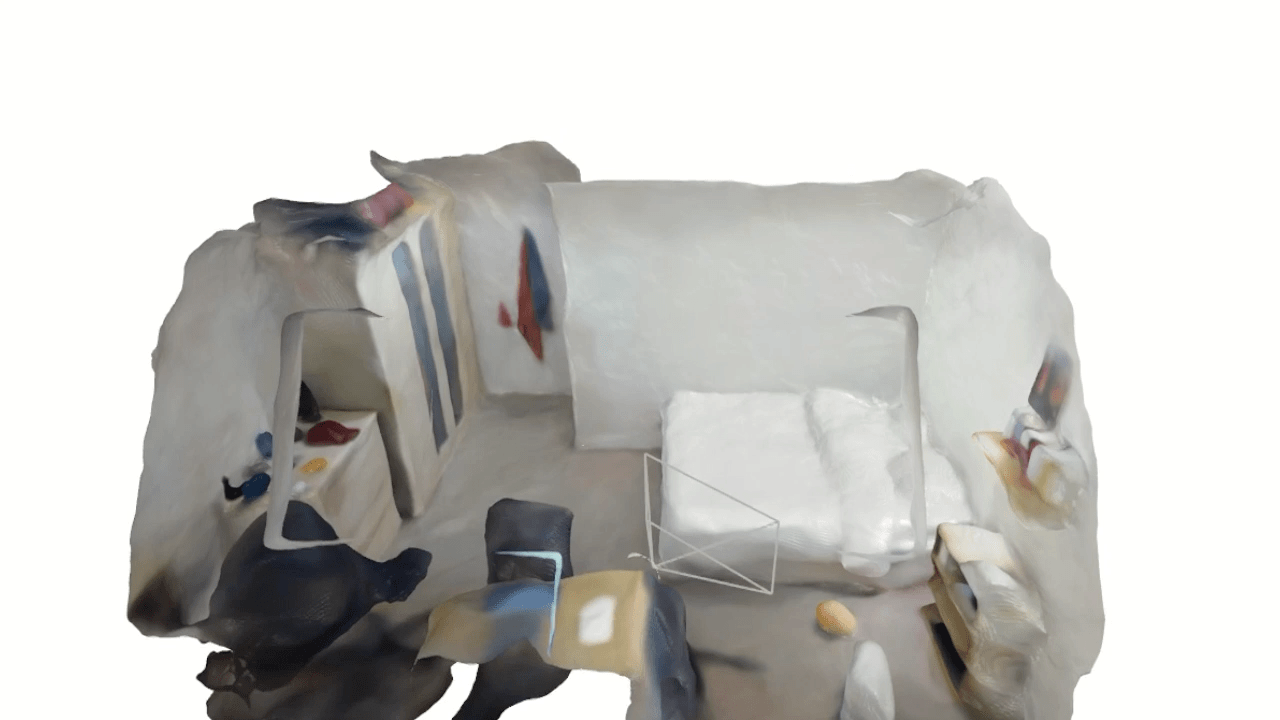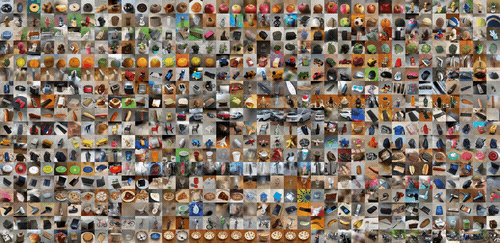NeRF at ICCV 2021
Published:
In anticipation of ICCV (Intl. Conf. on Computer Vision) this week, I rounded up all papers that use Neural Radiance Fields (NeRFs) that will be represented in the main #ICCV2021 conference. Many of the papers I discussed in my original blog-post on NerF made it into CVPR, but the sheer number of NeRF-style papers that appeared on Arxiv this year meant I could no longer keep up. The top Computer Vision conferences like ICCV and CVPR provide an (imperfect) filter to cut down on what to read, and I decided to read all the papers I could find in the ICCV main program. I share them with you below, after a brief review of NeRF.
Important note: all of the images below are reproduced from the cited papers, and the copyright belongs to the authors or the organization that published their papers, like IEEE. Below I reproduce a key figure for some papers under the fair use clause of copyright law.
NeRF
 A NeRF stores a volumetric scene representation as the weights of an MLP, trained on many images with known pose.
A NeRF stores a volumetric scene representation as the weights of an MLP, trained on many images with known pose.
NeRF was introduced in the (recent but already seminal) Neural Radiance Fields paper by Mildenhall et al. at ECCV 2020. Given a set of posed images, a NeRF model regresses density and color in a 3D volume using a multi-layer perceptron (MLP), that becomes a representation of the 3D scene. One can then use an easily differentiable numerical integration method to approximate a true volumetric rendering step.
As I have argued, the impact of the NeRF paper lies in its brutal simplicity: just an MLP taking in a 5D coordinate and outputting density and color. However, vanilla NeRF left many opportunities to improve upon:
- It is slow, both for training and rendering.
- It can only represent static scenes
- It “bakes in” lighting
- A trained NeRF representation does not generalize to other scenes/objects
Some of the early efforts to improve on NeRF are chronicled on my NeRF Explosion 2020 blog post. In a follow-up on that post, below are all the papers at ICCV’21 that I could find by scanning titles and reading the associated papers.
Fundamentals
Several projects/papers address the fundamentals of view-synthesis with NeRF-like methods in the original, fully-posed multi-view setup:
 Mip-NeRF address the severe aliasing artifacts from vanilla NeRF by adapting the mip-map idea from graphics and replacing sampling the light field by integrating over conical sections along a the viewing rays.
Mip-NeRF address the severe aliasing artifacts from vanilla NeRF by adapting the mip-map idea from graphics and replacing sampling the light field by integrating over conical sections along a the viewing rays.
MVSNeRF trains a model across many scenes and then renders new views conditioned on only a few posed input views, using intermediate voxelized features that encode the volume to be rendered.
DietNeRF is a very out-of-the box method that supervises the NeRF training process by a semantic loss, created by evaluating arbitrary views using CLIP, so it can learn a NeRF from a single view for arbitrary categories.
UNISURF propose to replace the density in NeRF with occupancy, and hierarchical sampling with root-finding, allowing to do both volume and surface rendering for much improved geometry.
NerfingMVS use a sparse depth map from an SfM pipeline to train a scene-specific depth network that subsequently guides the adaptive sampling strategy in NeRF.
Performance
The slow rendering/training of NeRF prompted many more papers on speeding up NeRf, mostly focused on rendering:
FastNeRF factorizes the NeRF volume rendering equation into two branches that are combined to give the same results as NeRF, but allow for much more efficient caching, yielding a 3000x speed up.
KiloNeRF replaces a single large NeRF-MLP with thousands of tiny MLPs, accelerating rendering by 3 orders of magnitude.

PlenOctrees introduce NeRF-SH that uses spherical harmonics to model view-dependent color, and then compresses that into a octree-like data-structure for rendering the result 3000 faster than NeRF.
SNeRG precompute and “bake” a NeRF into a new Sparse Neural Radiance Grid (SNeRG) representation, enabling real-time rendering.
RtS focuses on rendering derivatives efficiently and correctly for a variety of surface representations, including NeRF, using a fast “Surface NeRF” or sNerF renderer.
Pose-free
Another trend is to remove the need for (exact) pose supervision, which started with ‘NeRF–’ (on Arxiv), and is done by no less than three papers at ICCV:
BARF optimizes for the scene and the camera poses simultaneously, as in “bundle adjustment”, in a coarse-to-fine manner.

SCNeRF is similar to BARF, but additionally optimizes over intrinsics, including radial distortion and per-pixel non-linear distortion.
GNeRF distinguishes itself from other the pose-free NeRF efforts by virtue of a “rough initial pose” network, which uses GAN-style training a la GRAF, which solves the (hard) initialization problem.
Conditional
One of the largest areas of activity, at least in terms of number of papers, is conditioning NeRF-like models on various latent codes:
GRF is, like PixelNeRF and IBRNet at CVPR, closer to image-based rendering, where only a few images are used at test time. Unlike PixelNeRF GRF operates in a canonical space rather than in view space.
GSN is a generative model for scenes: it takes a global code that is translated into a grid of local codes, each associated with a local radiance model. A small convnet helps upscaling the final output.

GANcraft translates a semantic block world into a set of voxel-bound NeRF-models that allows rendering of photorealistic images corresponding to this “Minecraft” world, additionally conditioned a style latent code.
CodeNeRF Trains a GRAF-style conditional NeRF (a shape and appearance latent code) and then optimizes at inference time over both latent codes and the object pose.
Composition
Conditional NeRFs are the bread and butter of efforts that do various cool things with composing scenes:
EditNeRF learns a category-specific conditional NeRF model, inspired by GRAF but with an instance-agnostic branch, and show a variety of strategies to edit both color and shape interactively.

ObjectNeRF trains a voxel embedding feeding two pathways: scene and objects. By modifying the voxel embedding the objects can be moved, cloned, or removed.
Dynamic
At least four efforts focus on dynamic scenes, using a variety of schemes, including some that I already discussed earlier:
Teaser videos from the Nerfies web-page showing how a casually captured “selfie video” can be turned into free-viewpoint videos, by fitting a deformation field in addition to the usual NeRF density/color representation.
Nerfies and its underlying D-NeRF model deformable videos using a second MLP applying a deformation for each frame of the video.
NeRFlow is a concurrent effort, which learns “a single consistent continuous spatial-temporal radiance field that is constrained to generate consistent 4D view synthesis across both space and time”.
NR-NeRF also uses a deformation MLP to model non-rigid scenes. It has no reliance on pre-computed scene
AD-NeRF train a conditional nerf from a short video with audio, concatenating DeepSpeech features and head pose to the input, enabling new audio-driven synthesis as well as editing of the input clip.
DynamicVS is attacking the very challenging free-viewpoint video synthesis problem, and uses scene-flow prediction along with many regularization results to produce impressive results.
Articulated
Building on this, a cool trend is skeleton-driven NeRFs, that promise to be useful for animating avatars and the like:
NARF use pose supervision to train a small local occupancy network per articulated part, which is then used to modulate a conditionally trained NeRF model.
AnimatableNeRF use a tracked skeleton from mocap data and multi-view video to train skeleton-based blend-fields that then transform the radiance field, enabling skeleton-driven synthesis of people’s avatars.
Other
Finally, here are some other very cool papers using NeRF-technology that defy easy categorization:

IMAP is an awesome paper that uses NeRF as the scene representation in an online visual SLAM system, learning a 3D scene online and tracking a moving camera against it.
MINE learns to predict a density/color multi-plane representation, conditioned on a single image, which can then be used for NeRF-style volume rendering.
NeRD or “Neural Reflectance Decomposition” uses physically-based rendering to decompose the scene into spatially varying BRDF material properties, enabling re-lighting of the scene.
Semantic-NERF add a segmentation renderer before injecting viewing directions into NeRF and generate high resolution semantic labels for a scene with only partial, noisy or low-resolution semantic supervision.

CO3D contributes an amazing dataset of annotated object videos, and evaluates 15 methods on single-scene reconstruction and learning 3D object categories, including a new SOTA “NerFormer” model.
Finally, CryoDRGN2 attacks the challenging problem of reconstructing protein structure and pose from a “multiview” set of cryo-EM density images. It is unique among NeRF-style papers as it works in the Fourier domain.
Agenda for ICCV
For people attending ICCV, here is a quick guide to all the sessions where the papers above will be presented (all posted times are in EDT):
Session 3
Paper Session 3A and 3B: Tuesday, October 12 12:00 PM – 1:00 PM and Thursday, October 14, 7:00 PM – 8:00 PM
- CryoDRGN2: CryoDRGN2: Ab initio neural reconstruction of 3D protein structures from real cryo-EM images (Other)
Session 5
Paper Session 5A and 5B: Tuesday, October 12, 4:00 PM – 5:00 PM and Thursday, October 14, 9:00 AM – 10:00 AM
- Mip-NeRF: Mip-NeRF: A Multiscale Representation for Anti-Aliasing Neural Radiance Fields (Fundamentals)
- DietNeRF: Putting NeRF on a Diet: Semantically Consistent Few-Shot View Synthesis (Fundamentals)
- UNISURF: UNISURF: Unifying Neural Implicit Surfaces and Radiance Fields for Multi-View Reconstruction (Fundamentals)
- NerfingMVS: NerfingMVS: Guided Optimization of Neural Radiance Fields for Indoor Multi-View Stereo (Fundamentals)
- GNeRF: GNeRF: GAN-Based Neural Radiance Field Without Posed Camera (Pose-free)
- BARF: BARF: Bundle-Adjusting Neural Radiance Fields (Pose-free)
- SCNeRF: Self-Calibrating Neural Radiance Fields (Pose-free)
- PlenOctrees: PlenOctrees for Real-Time Rendering of Neural Radiance Fields (Performance)
- SNeRG: Baking Neural Radiance Fields for Real-Time View Synthesis (Performance)
- RtS: Differentiable Surface Rendering via Non-Differentiable Sampling (Performance)
- EditNeRF: Editing Conditional Radiance Fields (Composition)
- Nerfies: Nerfies: Deformable Neural Radiance Fields (Dynamic)
- AD-NeRF: AD-NeRF: Audio Driven Neural Radiance Fields for Talking Head Synthesis (Dynamic)
- DynamicVS: Dynamic View Synthesis from Dynamic Monocular Video (Dynamic)
- NARF: Neural Articulated Radiance Field (Articulated)
- IMAP: iMAP: Implicit Mapping and Positioning in Real-Time (Other)
Session 8
Paper Session 8A and 8B: Wednesday, October 13, 9:00 AM – 10:00 AM and Friday, October 15, 4:00 PM – 5:00 PM
- CO3D: Common Objects in 3D: Large-Scale Learning and Evaluation of Real-life 3D Category Reconstruction (Other)
Session 10
Paper Session 10A and 10B: Wednesday, October 13, 5:00 PM – 6:00 PM and Friday, October 15, 10:00 AM – 11:00 AM
- CodeNeRF: CodeNeRF: Disentangled Neural Radiance Fields for Object Categories (Conditional)
- NR-NeRF: Non-Rigid Neural Radiance Fields: Reconstruction and Novel View Synthesis of a Deforming Scene from Monocular Video (Dynamic)
- NeRD: NeRD: Neural Reflectance Decomposition from Image Collections (Other)
- MINE: MINE: Towards Continuous Depth MPI With NeRF for Novel View Synthesis (Other)
Session 11
Paper Session 11A and 11B: Wednesday, October 13, 6:00 PM – 7:00 PM and Friday, October 15,11:00 AM – 12:00 PM
- MVSNeRF: MVSNeRF: Fast Generalizable Radiance Field Reconstruction From Multi-View Stereo (Fundamentals)
- FastNeRF: FastNeRF: High-Fidelity Neural Rendering at 200FPS (Performance)
- KiloNeRF: KiloNeRF: Speeding Up Neural Radiance Fields With Thousands of Tiny MLPs (Performance)
- GSN: Unconstrained Scene Generation With Locally Conditioned Radiance Fields (Conditional)
- GANcraft: GANcraft: Unsupervised 3D Neural Rendering of Minecraft Worlds (Conditional)
- ObjectNeRF: Learning Object-Compositional Neural Radiance Field for Editable Scene Rendering (Composition)
- NeRFlow: Neural Radiance Flow for 4D View Synthesis and Video Processing (Dynamic)
- AnimatableNeRF: Animatable Neural Radiance Fields for Modeling Dynamic Human Bodies (Articulated)
Session 12
Paper Session 12A and 12B: Wednesday, October 13, 7:00 PM – 8:00 PM and Friday, October 15, 12:00 PM – 1:00 PM
- GRF: GRF: Learning a General Radiance Field for 3D Scene Representation and Rendering (Conditional)
- Semantic-NERF: In-Place Scene Labelling and Understanding with Implicit Scene Representation (Other)
Concluding Thoughts
It is clear that neural radiance fields have created somewhat of a revolution in the areas of 3D representation and view-synthesis, as evidenced by the 30+ papers above in a single conference, merely a year after the NeRF paper was published at ECCV. I have no “deep” thoughts to share about this at the moment, but I hope you at least enjoyed the rundown above!
